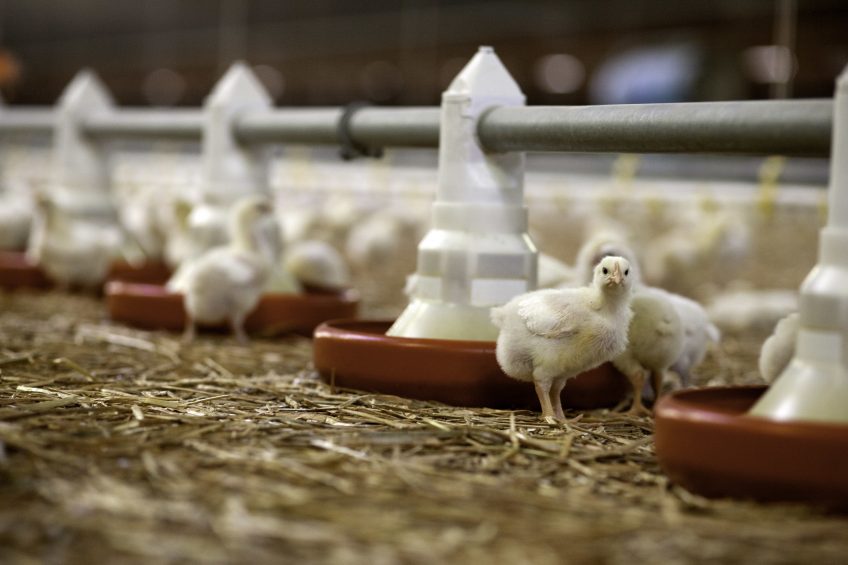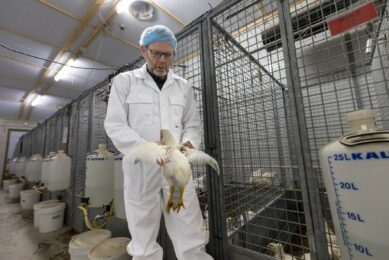Alpha-monopelargonin to improve broiler health and performance

Alpha-monopelargonin: a brand-new molecule for broiler health and performance. Reasons to upscale your feed with a-monoglycerides of the C9 fatty acid: pelargonic acid.
Watching the world go by ‘’sitting behind the geraniums” (an old Dutch saying) is not an option for Framelco. Instead we studied the leaves of the geranium (pelargonium) and found a special feature. The leaves of pelargonium contain natural esters of pelargonic acid, also known as nonanoic acid. It is this acid that has lead us to develop a new promising product for application in broilers.
Pelargonic acid is a clear, yellowish oily liquid with a strong unpleasant odour. It is described in literature that pelargonic acid has antimicrobial activities against harmful bacteria and fungi. Framelco has the expertise to turn fatty acids into non-corrosive, non-smelling glycerides. Moreover, monoglycerides in the alpha position are known to have a much better antimicrobial and antiviral effect compared to the respective free acid. Here we describe what we already have discovered about α-monopelargonin.
Improved product characteristics
Improving broiler health with acids can be accomplished by lowering pathogenic pressure. As mentioned before, pelargonic acid has anti-microbial effects. Many harmful pathogens colonise the intestine, but pelargonic acid has a pKa-value of 4.96 meaning at this pH 50% is dissociated and will have no anti-microbial effects. In contrast, α-monopelargonin is pH independent, meaning it will enter the intestine intact and can have local antimicrobial effects.
An in vitro growth curve test (see Figure 1) was performed against Staphylococcus aureus and the effect of a control sample, pelargonic acid (C9), α-monopelargonin (C9), a mix of caprylic acid (C8) with capric acid (C10) and a mix of α-monocaprylin (C8) with α-monocaprin (C10) was compared. In both cases the α-monoglycerides stopped the growth of the bacteria, where the control and free fatty acids were not able to do the same.
Figure 1 – Effect of pelargonic acid (C9), α-monopelargonin (Mono C9), caprylic acid + capric acid (acid C8/C10), α-monocaprylin + α-monocaprin (Mono C8/C10) and control (DSMO) on the bacterial growth of S. aureus over time (hours). The graph represents the mean of 2 independent tests.

Anti-inflammatory properties
Broiler health and performance can also be improved via other ways than only reducing pathogen load. At the laboratory of Prof. Niewold at KU Leuven in Belgium, an in vitro model is available to study the potential anti-inflammatory effects of compounds. In this model, macrophage-like cells are used and are challenged with lipopolysaccharides (LPS). Upon this challenge, the macrophage-like cells will produce Nitric Oxide (NO). When the test compound reduces NO production, it means that the compound has anti-inflammatory properties.
The inhibitory concentration 50 (IC50) indicates from which dose level onwards the anti-inflammatory effect is. Oxytetracycline (OTC) was used as a control group and from it became clear that OTC showed the expected reduction in NO production at IC50 of 400 ppm. Alpha-monopelargonin also showed a clear reduction of NO production at IC50 of 1000 ppm (Figure 2).
Figure 2 – Effect of α-monopelargonin and OTC on NO production by LPS challenged macrophage-like cells.

Broiler performance
A first trial was conducted to see the effect of pelargonic acid and α-monopelargonin. The trial was carried out at the facilities of Feed Innovation Services, which is a research institute in the Netherlands. 189 one-day-old female broilers (Ross 308) were randomly distributed over a wire-floor, in suspended cages of 6 chickens each.
3 treatment groups were designed:
- a control group
- a group receiving α-monopelargonin
- a group receiving pelargonic acid (C9)
Dose levels for both groups receiving a C9 product were: 3 kg/ton starter feed (day 0-10), 2 kg/ton grower feed (day 10-25) and 1 kg/ton finisher feed (day 25-35), see Table 1.
There were no health issues during the trial. In the first 25 days of the trial growth was increased in the α-monopelargonin group whereas the growth was reduced in the pelargonic group compared to the control. Overall, broilers in the α-monopelargonin group had at day 35 a 2% higher body weight. FCR was improved with 5.4 points (3.68%) in the α-monopelargonin group compared to the control group. Feed intake was not negatively affected by adding the glyceride, but it was with pelargonic acid, maybe because of it bad smell. This first trial shows that α-monopelargonin can be a tool to improve broiler performance under good conditions. Even more effect is expected in field situations with poorer health status and lower performance of the animals.
Conclusions
Framelco has the expertise to turn fatty acids into non-corrosive, non-smelling glycerides. The alpha-monoglyceride of pelargonic acid have shown to have a better effect on improving broiler health and performance. Furthermore, α-monopelargonin has strong antimicrobial and anti-inflammatory properties. These are very promising results and give confidence to α-monopelargonin as a real growth supporter, improving broiler health and performances even in non-challenging conditions. Further research will be conducted in situations with poorer health status and performance.
Join 31,000+ subscribers
Subscribe to our newsletter to stay updated about all the need-to-know content in the poultry sector, three times a week. Beheer
Beheer








 WP Admin
WP Admin  Bewerk bericht
Bewerk bericht